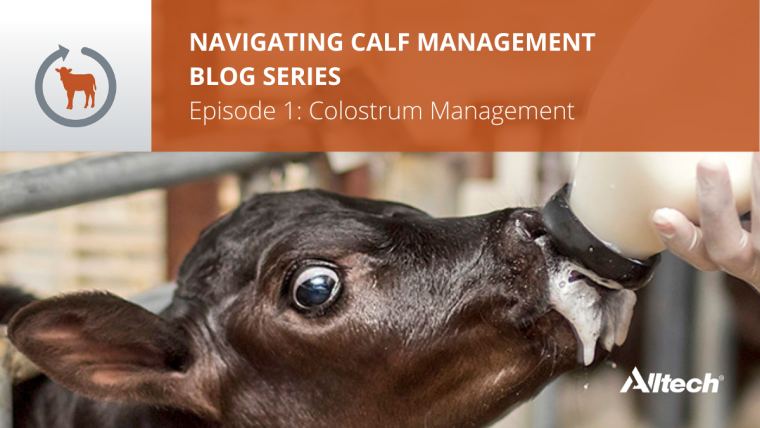Colostrum management key to unlocking genetic potential

This is the first episode of our ‘Navigating Calf Management’ blog series designed to help UK dairy producers lay early foundations for long and productive lifecycles. This important and complex topic has been broken down into four areas, including:
Episode 1: Colostrum
Episode 2: Environment
Episode 3: Weaning
Episode 4: Calving
The first in this series of four blogs provides advice on colostrum management, regarded as the key to unlocking true genetic potential in your herd.
Rearing replacement heifers is the second-largest expense on dairy farms and cow-calf operations, accounting for around 20–30% of annual production cost after feed. Furthermore, statistics show significant performance variations between calves, even those born on the same farm.
Getting the first few months of life right can have a huge impact on calf mortality and growth rates in early life, not to mention milk production and feed efficiency in future lactations. It is both a short and long-term game, and you will reap great rewards when cows hit maturity.
Cat Berge of Berge Veterinary Consulting is an independent consultant for Alltech.
“The number one cause of early mortality is due to poor colostrum management. It contributes to the cause of 50 percent of calf deaths”, advises Berge.
The colostrum provided in the first hour to 24 hours of life is vital. It provides calves with the antibodies that provide natural immunity, energy, vitamins and nutrients essential for growth and development.
The 5Qs of colostrum management protocol:
1. Quality
- Goal: IgG > 50 g/l, or >23% when measured with a Brix refractometer.
2. Quantity
- Goal: 10% of birth weight at first feeding and 4 litres up to 10 hours later.
3. Quickness
- Goal: Within 1–2 hours of birth — for calves born at night, make it the first priority in the morning with a 4-litre tube of frozen or powdered colostrum.
- Every 1-hour delay in colostrum feeding, the chance of the calf becoming ill increases by 10% (Jemburu. 2004).
4. SQueaky clean
- Goal: <100,000 cfu/ml total bacteria count and <10,000 cfu/ml faecal coliform count.
5. Quantifying (monitoring) passive transfer
- Goal: >90% of calves with blood serum TP ≥ 5 g/dl
Active research has shown that bacteria-contaminated colostrum can interfere with and reduce the passive absorption of colostral antibodies. Therefore, cleanliness is becoming a key focus area when seeking to minimise calf disease.
The 6-step protocol to reduce bacterial counts:
1. Milking
When the fresh cow is milked, ensure the teats are as clean a possible following the Dip-Wipe-Dip-Wipe/Scrub method using the pre-dip solution or an iodine-based solution.
2. Collecting
Ensure the equipment used for collecting colostrum is clean and free from any biofilm. This can be done using chlorinated detergent and scrubbing with a stiff bristle brush and green scouring pad. Ensure water is kept above 48.9°C and follow the Rinse-Wash-Rinse-Dry protocol. Follow this step for all buckets and feeding equipment too.
3. Chilling
Unless being fed straight away, place two frozen 2-litre bottles of water into the dump bucket to rapidly cool the colostrum to around 16°C. Coliform bacteria take 150 minutes to double at 16°C compared to 20 minutes at cow body temperature, 38°C.
4. Storing
Colostrum should be tested for quality and good colostrum stored in a fridge for no longer than 24 hours in 1–2-litre containers. Alternatively, it can be frozen immediately in 1–2-litre zip bags. Ensure all colostrum is labelled with collection date and cow identity.
5. Reheating
Frozen colostrum can be thawed in a refrigerator overnight. Both fresh and frozen should be warmed in a water bath (50°C max), so the colostrum reaches 40–42°C, giving time for it to cool to 38°C before feeding. Once warmed, feed the colostrum within 30 minutes.
6. Feeding
Bacteria love to grow in damp, dark places. Ensure that all feeding equipment is thoroughly cleaned and sanitised. Paying particular attention to crevasses and small, hard-to-reach areas. Also examine bottle nipples regularly; these can be the perfect environment to bacterial growth.
The benefits of taking your time and getting it right
Ensuring good calf nutrition, starting with the first feed, can allow the calf to reach her true potential in later life. Feeding 4 litres over 2 litres has been found to produce 550 kg more milk during the first two lactations and lead to a 16% increased survival to third lactation (Faber et al., 2005).
Additionally, every 100 g extra daily gain pre-weaning can lead to 150–155 kg more milk during first lactation (Geisnger & Heinrichs, 2016).
Good colostrum management is your key to unlock future production. If you have any questions or require any personalised advice, please contact your local advisor or call our InTouch Hub on 0800 587 3297.














